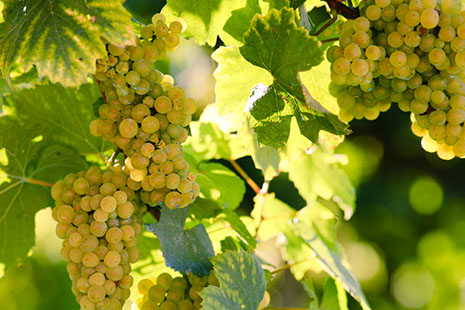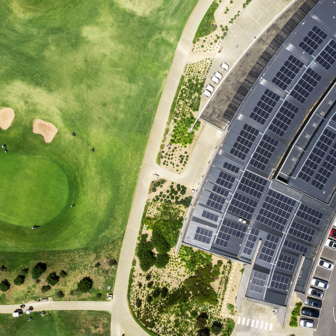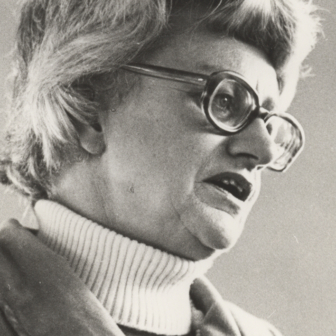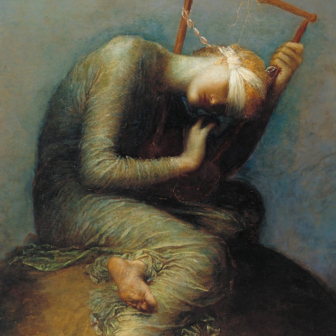THE MODEST historic marker in a dusty lay-by just north of Melrose purports to sit on Goyder’s Line, but the locals aren’t so sure: some think it should be a kilometre or so to the south. In sixty years time, if the grimmest projections of climate change science are right, this will be the driest of arguments. Projections say that by 2070, Goyder’s Line, regarded as the northern edge of South Australia’s arable land since the late nineteenth century, could have migrated as far south as Clare, 120 kilometres away.
The Line has been part of South Australian folklore and vocabulary for nearly 150 years. Early vineyards were already thriving in the Clare Valley when South Australia’s surveyor-general, George Woodroofe Goyder, headed north through the town at the behest of the colony’s government in 1865. Goyder made an extended tour of the mid-north to map the extent of a fierce drought. As he painstakingly traversed the landscape on horseback, he made a shrewd and, it would later emerge, remarkably accurate assessment of the limits of reliable rainfall. He relied primarily on cues provided by soil and vegetation types, particularly the zone of transition from native grass and woodland to drought-tolerant saltbush. His imaginary line turned out to be, in effect, an isopleth; north of his line, average annual rainfall averaged less than 300 millimetres (or twelve inches), which to Goyder’s mind made the prospects for settled agriculture too risky to be contemplated.

Goyder’s Line, from On the Margins of the Good Earth, by D.W. Meinig (Rand McNally, 1962).
For his pains, the industrious Goyder was subjected to a barrage of derision. His early trips to the mid-north to survey, rate and value land suitable for cultivation had been vehemently opposed by a group of wealthy and influential pastoralists, who, prior to the valuations, ran their sheep in the colony’s northerly expanses at minimal cost. Once the Line was declared, Goyder was set upon by lobbying farmers. Not content with the areas released for selection, the farmers argued that neither government nor Goyder should act as an impediment to settlement. They denounced the Line as a “theoretical bauble,” pointing out that similar lines drawn across the colony in previous years had all been abandoned. And in any case, they argued, rain followed the plough.
The Line and its creator were jeered in parliament and belittled in the newspapers. In a mock tribute, one cartoonist drew a statue of Goyder seated backwards on his horse. The government bowed to populist pressure, declaring dozens of new “hundreds” – roughly hundred-square-mile blocks – well to the north of the Line for agricultural subdivision. And throughout the 1870s, with ten successive seasons of plentiful rains north of the line, newly established plantings of wheat produced bumper yields.
But in the early 1880s, for three years in a row, no winter rains materialised: crops in the newly selected areas failed and many farms north of the Line were abandoned. Goyder found himself vindicated and the Line entered the minds of rural South Australians as a cautionary tale, signifying an invisible but immutable demarcation between hope and despair.
The idea of the Line marching 120km south is very much a worst-case, nightmarish scenario: median predictions, drawn from a range of climate projection models, point to a loss in annual rainfall of five to ten per cent by mid-century, which would translate to a much more modest 20km shift in the Line. And even this may not eventuate – as Dr Peter Hayman of the South Australia Research and Development Institute readily admits, while rainfall is the most worrying parameter of climate change, it is also the least predictable.
Hayman, who has modelled climate change in South Australia extensively, says that global climate models aren’t at all clear, and actual rainfall in South Australia has to date failed to align with any of a dozen climate model projections. “In coming years, there is no certainty about a major shift in rainfall,” he told me recently.
While scientists do believe a southerly shift in the Line is likely, they concede the possibility that total annual rainfall may increase across parts of South Australia. This may not prove a source of any great comfort though; up around the margins of the Line, recent years have produced a pattern of rainfall characterised by unseasonal summer downpours, while the spring rains, so vital to wheat growers, have failed to show up at all.
Hayman nonetheless remains hopeful, even for the marginal enterprises along the Line that are geared to survive economically on one good year in five. “If we keep getting disastrous failed springs, then it will be very hard for anyone to survive, but there is no clear scientific sense that is necessarily going to be the case – even on a declining rainfall we would expect some good years as well.”
There is no doubt, however, about the consequences if the Line descends on Clare: the valley’s vineyards would be devastated. Hayman says the region’s rainfall would be effectively halved, leaving it with annual precipitation akin to the current rainfall of Orroroo, just north of the Line. While a few canny wheat farmers in the vicinity of Orroroo manage to eke out a living, it’s no place to grow wine grapes.
SITUATED at around 400 to 500 metres above sea level, the Clare Valley averages more than 500 millimetres of rain a year. In winemaking parlance, the region is classified as cool to warm, a label that might puzzle a casual observer of the searing summer temperatures. But the measurements taken at the town’s central recording station don’t begin to tell the full story. The winegrowing region is spread along a thirty kilometre strip that begins at Auburn, with Clare near its northern apex, and vines are cultivated to the west and east of the main road in a bewildering range of topographic settings and sites, which display considerable variations in altitude, temperature, rainfall and soil types.
Despite their differences, nearly all of the Valley’s forty-plus wineries have riesling in common. The grape is the region’s totem and the mainstay of its reputation. Excellent shiraz and cabernet sauvignon are also produced, but it is the rieslings, especially those from the subregions of Watervale and Polish Hill River, which consistently elicit admiration from wine writers and wrest trophies from show judges. In Clare, the world-wide imperialism of chardonnay has gained little traction – riesling vines outnumber chardonnay by three to one.
Winemaking in the region goes back to the mid-nineteenth century, and riesling was among the earliest cultivars. It was the grape behind Spring Vale (later Quelltaler) Hock, a label that defied British snobbery towards colonial wine by becoming one of Australia’s first and most enduring export successes.
Today, Clare Valley riesling is typically made in a distinctively dry, steely style that sets it apart from its spicier German relative. To achieve wine of the highest quality, winemakers favour minimal intervention, striving to exclude oxygen in order to preserve the delicate fruit flavours, and focusing on the point at which to cease fermentation, which determines the level of dryness. In terms of its ripening range, riesling needs to remain longer on the vine than grapes such as pinot noir or chardonnay, but requires less sun exposure and earlier harvesting than shiraz or the famously tardy cabernet sauvignon.
Neil Jericho is a vineyard manager at Taylors; with production nudging 600,000 cases a year, the winery is by far the largest producer in the Clare Valley. Jericho says that while wine companies are aware of the need to keep a weather eye on the threats posed by climate stress, they rely on scientists like Peter Hayman to collect the data and present them with evidence. Jericho accepts the reality of climate change, but tends to see the shift as part of a slowly progressing natural cycle, and believes significant effects are likely to occur over generations, “rather than in my working lifetime.”
This is not to say that the valley’s viticulturists are twiddling their thumbs. Taylors, like many other wineries in the region, is already exploring ways to protect their vines from the effects of heat and implementing measures to conserve water. Jericho says that regardless of the rate of climate change, such measures make good economical and ecological sense. Taylors employs mulching under the vines as a simple means of simultaneously reducing evaporation and decreasing radiant heat. To further lessen evaporation, irrigation hoses have been taken underground. More costly steps, such as putting covers on dams, may be contemplated in the future.
While the scientific uncertainty about future rainfall may be good news of sorts for Clare, temperatures are not only on the rise, but are hugging the upper range of modelling projections. “Internationally,” Hayman told me, “climate science would say that we are at the upper end of the envelope in terms of emissions, of temperature and sea level rise.”
Using CSIRO data, Hayman’s projections for 2030 are a rise in temperature of up to 1.5 degrees, while 2070 could see temperatures climbing by as much as five degrees. And Clare may have to face more than a creeping elevation of average temperatures; one anticipated effect of climate change is more extreme weather events, and there is gathering evidence that the frequency of severe hot spells of weather is increasing.
In 2008, South Australia experienced a sustained run of extreme heat, but it came in March, late enough to miss the riesling crop altogether. This year, another burst of heat came in the weeks after Australia Day. South of Adelaide, successive record-breaking days of savage heat cut a swathe through the vineyards of McLaren Vale, shrivelling leaves and scorching and desiccating the nearly mature bunches. The white wine crop suffered losses of up to 70 per cent in the worst affected vineyards.
Clare wasn’t spared the record heat, but it did come before the crop had reached “veraison,” the change that marks the start of the ripening phase, when the berries begin to acquire colour and draw on the photosynthesis by the leaves to accumulate sugar. The exertion leaves the vines vulnerable. Because of the timing, Neil Jericho says that damage in Clare was comparatively light.
Clare’s complex topography and its variety of terror and microclimates also helped to dilute the effects. According to Peter Hayman, there was a whole suite of different experiences in Clare. “Some blocks or parts of blocks were affected,” he said, “others survived happily.”
He believes winegrowers are ideally placed to monitor the nuances of climate change. “Viticulturists are very conscious of stages of crop growth – when budburst is happening, when flowering or veraison is happening and, most importantly, when harvest and vintage is happening. And crop development is highly sensitive to even small changes in temperature.”
Some vignerons are already registering concern. There have been reports from cool climate vineyards in Victoria that varieties such as pinot noir, which formerly struggled to ripen, are now accruing too much sugar too quickly because of hotter temperatures, putting at risk their all-important complexity and finesse. Rick Kinzbrunner, winemaker and proprietor of Giaconda winery in Beechworth, has said he can foresee the day when his chardonnay and pinot noir vines will have to be replaced with heat-friendly shiraz.
Like the Victorian vignerons, Stephen George believes the effects of climate stress are already making their presence felt. George is a Clare “old boy”: he cut his oenological teeth making riesling at Skillogalee, the winery founded by his father, Spencer, in the 1970s. The Clare subregion in which it sits is a few kilometres west of Penwortham, one of the tiny townships that dot the main Clare road, and is also home to premium riesling makers Mitchell and Kilikanoon.
George, who now operates from the colder Adelaide Hills region, believes that Clare faces problems from warmer temperatures sooner rather than later. “Call it climate change or drought or just call it weather, but even here in the Adelaide Hills it has been getting warmer and drier for the past few years,” he said. His concerns have been triggered by one simple statistic: over the past five years, the dates for picking all of his varieties have been creeping backwards. Vintage is coming earlier.
Based on his own observations, George says high temperatures are already altering the flavour profile of wine grapes, most notably in the form of heightened phenolics. Phenolics are compounds that occur in the stalks and skins of grapes; as well as being responsible for colour, they have a role in a wine’s mouthfeel, but in excessive amounts can taste astringent or even bitter. George believes that the riesling makers of Clare will be dealing with higher levels of phenolics, especially tannins, in their raw material. He suspects higher tannin levels derive from a thickening of the grape’s skin, triggered by high temperatures during early phases of berry development as a mechanism to protect the fruit from heat damage. “It’s a theory which seems to fit, but of course more research is necessary,” he said.
If riesling does start to display unwanted harshness from tannins, George says that winemakers will have to resort to increased fining, a process that enlists a faintly bizarre catalogue of substances to remove unwanted characters. For riesling, a variety that relies for its quality on a very light touch from the winemaker, it is not good news.
YET IT’S HARDLY a death knell, either. The Future of Wine Report, published last year by British wine merchants Berry Brothers and Rudd, provocatively predicted the total disappearance of winegrowing from the Australian mainland by 2056. But, as Peter Hayman re-emphasises, Goyder’s Line reaching Clare is “the very, very extreme scenario.” He believes the region can successfully adapt to less drastic expressions of climate change, including a decline in rainfall, for the foreseeable future. “Especially in an area like Clare that is so complex geographically, it’s very hard to talk about a single impact.”
“The amount of water used per hectare is relatively small in viticulture,” he told me. “Many vineyards in Clare are virtually dry grown, so we are talking about very modest amounts of water being put on, because it’s a high quality region. It’s clear to me that the future for these regions is to have modest irrigation use and modest yields. The sense I have is that the most likely outcome is that regions like Clare and the Barossa would perhaps retreat to a tighter area: the more recent expansion, planted on less suitable soils and less suitable sites, would be threatened before the earlier sites selected.”
Hayman believes that the wine industry is well equipped to respond and willing to share ideas. “It’s a well-connected industry, and it has a lot of people with a combination of tertiary training and hands-on experience. There’s a lot of interest in climate change, and there’s a lot of adaptive capacity within the industry.”
His conclusion is optimistic. “Neither climate models nor the deliberations of George Goyder 150 years ago factor in the additional complexity of having smart humans involved.” •




